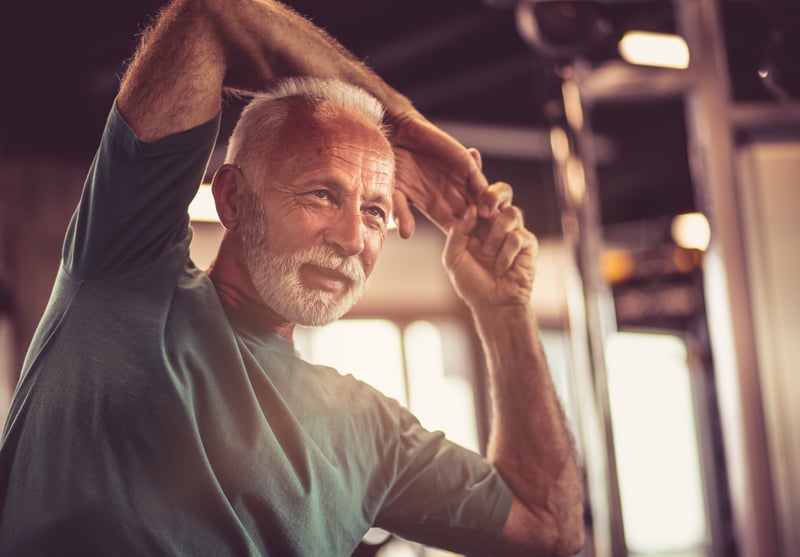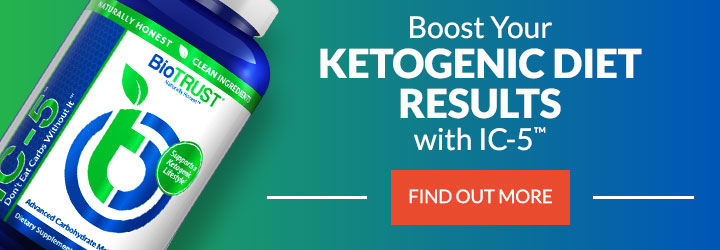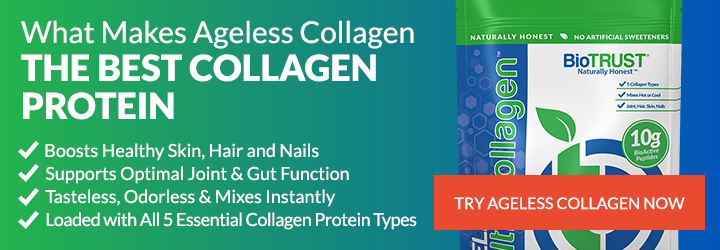9 Easy Ways You Can Age-Proof Your Joints

Are you one of the 52 MILLION otherwise healthy Americans who suffer from woefully worn-out, stiff, and achy joints?1 Simply put, tired, worn, and stiff joints can limit you from doing what you love and living the life of your dreams.
The ability to play with your kids or grandkids, enjoy sports and activities, the pleasure of a simple walk around the neighborhood… The freedom to leisurely work around the house…gardening, laundry, freely traveling up and down the stairs, or even just getting in and out of a chair.
The fact is, these concerns and the reality of declining joint health are no laughing matter. Even worse, it seems almost inevitable that normal lifestyle and age-related joint issues will plague nearly everyone at some point.
The good news, though, is it doesn’t have to be that way. With these nine tips to age-proof your joints, you can swing the balance heavily in your favor.
Signs Your Joints Are Starting to Age
Research shows 43% of all adults over the age of 45 struggle with significant joint discomfort in their hands, knees, hips, ankles, feet, and/or backs. 2 Even worse, statistics show that by age 65, a whopping 80% of the population will have experienced compromised joint structure—an issue that only continues to get worse with time if not proactively addressed. 3
Are you already experiencing any of these signs of old, worn-out joints?
- Activity-related joint flare-ups and swelling
- Poor sleep quality due to joint discomfort
- Joint stiffness, particularly in the morning
- Limited movement and flexibility, making it difficult to exercise, climb stairs, or other activities
- Grinding, crackling, or popping sensations and sounds
- Achy joints when sitting, standing, or performing simple movements
Ask yourself, is this same joint discomfort disrupting your life, preventing you from doing the things you love most? Have you been sidelined due to your struggle with nagging joint distress? Even more sobering, are you concerned about losing your freedom due to declining joint health? As you already know, joint discomfort and stiffness impair mobility, adversely affect daily activities, and negatively impact quality of life. 4,5
Even worse, the majority of folks turn to options like acetaminophen and non-steroidal anti-inflammatory drugs (NSAIDs) to relieve joint discomfort, reduce stiffness, and improve physical function. While these tend to be effective short-term, regular, consistent use of NSAIDs has been found to be associated with a number of adverse health outcomes. This can include gastrointestinal (GI) discomfort, enhanced risk for GI bleeding, high blood pressure, congestive heart failure, renal insufficiency, and more. 6–8
I don’t want that for you! With that in mind, here are nine tips to help age-proof your joints without having to turn to potentially dangerous, health-ravaging drugs.
9 Ways to Age-Proof Your Joints
1) Turn back the clock
It’s probably not all that surprising that age is heavily correlated with painful, worn-out joints. It makes sense: The longer you’re alive, the longer your body has to weather the storm (of repeated insults), so to speak.
But just because the two are associated doesn’t mean that crippled joints are inevitable.
Emerging scientific research provides clear evidence that it is indeed possible to turn back the clock on an aging body. It starts by addressing key lifestyle factors—such as these 10 steps to reduce your body age—many of which I’ll be discussing below.
The bottom line is that just because something is “age-related” doesn’t mean it’s destiny. In fact, most of the health problems that fall into this bucket are actually “lifestyle-related.” That means they’re the result of consistent, persistent abuse/neglect.
2) Lose weight
I admit this is arguably the most worthless, insensitive, and dumb coaching advice I could probably give. I can’t remember a single client who’s had weight-loss success when just given those two words of advice.
But it’s true. Along with getting older, excess body fat is the major risk factor associated with declining joint health and increased joint discomfort. 9,10
Obviously, a heavier body puts more mechanical stress on weight-bearing joints (such as the knees, hips, ankles, and spine). Being just 10 pounds overweight can mean an additional 30 – 60 pounds of force on each weight-bearing joint with each step. 11 In addition to the direct burden it has on weight-bearing joints, extra weight can also wear out non-weight bearing joints (e.g., hands) as well.
“Obviously, you don’t walk on your hands, so there may be something produced by fat cells in the body that causes the joint to break down more rapidly than it might otherwise,” says Dr. David Felson, a professor of medicine and epidemiology at Boston University School of Medicine. 12
It’s true, beyond the beating your joints take from carrying extra weight, excess body fat can further wreak havoc on your joints by secreting a large number of hormones and chemicals (e.g., cytokines) tied to the inflammatory response. And in turn, that can worsen already compromised joints. 13–16
The bottom line is if you want to age-proof your joints, you need to get serious about taking steps to maintain a healthy weight. The good news is that’s basically the entire crux of our blog—to help you achieve deep health—not to mention many of the steps we cover here have the added benefit of shaving off unwanted pounds.
3) Move—but don’t beat up—your body
It’s not just old age and being overweight that can hamper joint health and mobility. Being active, either as part of your job or as an avid exerciser, can lead to joint degradation. And sports activities, exercise, and occupational activity increase the odds of joint discomfort and reduced mobility. 17–26
Essentially, the more you use your joints, the greater toll they take and, ultimately, the more joint issues can develop over time. Now, this is particularly true for overuse, which is often the result of performing the same types of movements over and over—whether that’s running, throwing, or job-related work. (I suppose you could make the argument that sitting could lead to overuse problems as well, but obviously, that doesn’t fall under the umbrella of moving.)
At the same time, we know regular exercise is good for virtually every aspect of the body, including your joints. The key is choosing a steady, yet diverse diet of pain-free exercise that involves moving the body through the widest range of motion and movements possible. Incorporate strengthening, low-impact aerobics (e.g., cardio, intervals), neuromuscular education (e.g., activation and balance exercises), and stretching exercises. Speaking of stretching…
4) Streeeetccchhh it out
Like it or not, stretching is an essential piece of the puzzle when it comes to age-proofing your joints. Quite simply, flexibility is defined as the ability to move a joint or series of joints through a full, non-restricted, pain-free range of motion. In other words, your muscles control your joints, so if you want healthy, pain-free, mobile joints, then you need to ensure optimal muscle flexibility. 27
Muscles are not dumb, static pieces of flesh. They’re highly dynamic structures, which are heavily influenced by our repeated actions. They are continually receiving inputs from the work asked of them, and their length is governed by the nervous system. And when it comes to muscular flexibility and joint mobility, if you don’t use it, you lose it.
Along those lines, when a muscle feels tight, it could be because it hasn’t been used in that range of motion regularly. It could also be a sign that the body is out of balance due to repetition of movement (or lack thereof).
Said differently, muscles don’t necessarily become “short” or “tight.” Rather, due to abuse, neglect, and/or overuse over time, certain muscles may have a higher neural drive, which leads to a shift in joint structures away from neutral.
I know that may be a little thick in the weeds, but the take-home point is that if you want to maintain age-proof, pain-free joints, your movement practice better contain a healthy dose of flexibility training.
5) Get your beauty rest
The association between sleep and pain may be complex. But the reality is that it’s pretty straightforward. Joint pain can lead to some restless nights. On the other side of the coin, poor sleep can lead to painful joints.
Without getting too deep, experimental studies suggest that sleep disturbances—such as not getting enough sleep or not getting good-quality sleep—impair key processes that contribute to the development and maintenance of chronic pain, including joint pain. 28
In one study, for example, researchers found that sleep deprivation significantly heightened sensitivity to pain among the group of male participants. When the participants were allowed “recovery sleep,” the researchers found it was more powerful—from a pain-relief standpoint—than that of common over-the-counter pain-relief drugs.
The take-home point is that getting plenty of restorative sleep (usually in the neighborhood of 7 – 9 hours for most) is mission-critical for bulletproof joints. Of course, “get plenty of good sleep” is about as helpful as “lose weight” when it comes to coaching advice. The good news is that you can put yourself in the best position possible to rest long and well by taking inventory of your sleep hygiene.
6) Manage your blood sugar
Poor blood sugar management—aka glycemic variability—is one of the biggest, albeit overlooked, factors that affects a variety of longevity and chronic disease parameters. Long story short, managing your blood sugar has to do with way more than staving off diabetes.
From a joint health standpoint, high glycemic variability—which refers to the intensity and level with which blood sugar fluctuates—leads to the creation of advanced glycation end-products, also known as AGEs. This is a fitting acronym for a group of compounds that can wreak havoc on the cells and structures of the body. 29
When it comes to crippling joints, AGEs can impact the mechanical properties of cartilage. As a result, AGEs can increase joint stiffness, increase joint fatigue, and inhibit the building of new, healthy joint tissue. 10
What’s more, AGEs increase free radical formation, impair antioxidant defense systems, increase oxidative stress, and promote inflammation. 30 Along those lines, joint degradation is thought to be precipitated by several factors, including oxidative and inflammatory stress. 31–33
The bottom line is that taking steps to lower glycemic variability and manage blood sugar are key to supporting healthy joints as you age. No, you don’t have to go on a keto diet (although that might help).
But it is a good idea to do things like strength training, pre-breakfast fasted cardio, taking walks after meals, and standing more (and sitting less) to promote the body’s disposal/use of glucose. Consuming dietary fiber (via bacterial fermentation) and certain herbs and spices (like berberine and cinnamon) can also help by improving insulin sensitivity.
7) Load up on joint-nourishing superfoods (and ditch the junk)
Let’s talk about the elephant in the room: Diet.
According to renowned joint health expert Dr. Jason Theodosakis (“Dr. Theo”), “We now know that certain foods can actually help ease and promote joint comfort.” 34
On the one hand, you have the typical American diet. It’s characterized by overeating and poor food choices, typically rife with refined carbohydrates (like refined grains and added sugar) and low-quality refined vegetable oils (like soybean, canola, corn, cottonseed, safflower, and sunflower oils). This pattern of eating leads to an overproduction of free radicals, which results in oxidative stress and inflammatory stress—two major drivers of achy, worn-out joints. 35–37
On the other hand, diets rich in fruits and vegetables—which are abundant in antioxidants, a major help in fighting free radicals—are inversely associated with inflammatory stress. 38
According to Dr. Theo, foods that contain vitamin A (e.g., beta-carotene), vitamin C, vitamin E, and/or selenium (collectively known as the “ACES”) are powerful weapons for combating free radicals and supporting superior joints.
Speaking of antioxidants, there are a number of phytonutrients (e.g., flavonoids, anthocyanins, carotenoids, plant sterols, glucosinolates) found in an array of plant-based foods that can have a tremendous effect on joint health by supporting the body’s antioxidant defense systems, reducing oxidative stress, and promoting a healthy inflammatory response. In addition, a number of other micronutrients (e.g., vitamin D, vitamin K, several B vitamins) may play a critical role in optimizing joint health and function. 39
While there’s no single “best” food to age-proof your joints, here are some of the top choices:
- Avocados
- Olive oil
- Cherries
- Apples
- Blueberries, strawberries, and other berries
- Red wine
- Cold-water, fatty fish
- Broccoli and other cruciferous veggies
- Brazil nuts and other nuts
- Dairy, yogurt, and other fermented foods
Rather than hone in on a single food, however, a better idea would be to embrace an anti-inflammatory diet. That is, a diet that emphasizes anti-inflammatory foods and minimizes pro-inflammatory foods, addresses lifestyle factors that influence inflammation, and minimizes environmental insults that promote unhealthy levels of inflammation.
8) Thermal Therapy
Both sauna bathing and cold exposure can help alleviate joint-related pain, and sauna bathing also seems to improve joint mobility. There are multiple different forms and applications of these two forms of therapy, and you may have to experiment with each to find what works best for you.
To take a deeper dive—and discover even more benefits—check out the following articles:
9) Employ the power of a joint-health superstack
I saved supplements for the end of the show because, in a perfect world, they’re like the icing on the cake. In other words, while they can be tremendously helpful and powerful, they’re meant to complement—not replace—healthy behaviors.
(Although I doubt research participants are required to check off all the above boxes first before enrolling in the studies that provide robust and compelling evidence in favor of the ingredients in the following supplements.)
Here are some of my favorite joint-health supplements, which I commonly recommend to folks who are looking to age-proof their joints (including my own parents who swear by this combo and won’t go a day without it):
Multi-Collagen
Besides water, collagen protein is the most abundant substance in your body. As the body’s primary structural protein, it’s literally the glue that holds you together. And when it comes to your joints, collagen makes up approximately 70% of your joint cartilage. There’s a problem, however. In fact, it’s a two-headed monster.
On the one hand, your body’s natural production of collagen plummets beginning at the age of 20. (Leaving you with roughly half the collagen of your youth by the time you’re middle-aged.)
To make matters worse, hardly anyone is consuming this incredibly important protein (which you’d find in things like animal bones and hides and fish bones and scales). This makes supplementing with collagen protein a must. More specifically, I recommend Ageless Multi-Collagen, which stimulate the body’s production of collagen, provide the raw materials for collagen-building, and practically speaking, have been shown in multiple studies to support healthy, mobile joints. 40,41
Curcumin
Besides collagen, there’s probably not a more well-recognized joint-health superhero than curcumin, which helps maintain a healthy inflammatory response throughout the body. In doing so, curcumin provides relief from occasional joint aches and stiffness. Ageless Body, our all-star formula, features the joint-health superhero CurcuWIN®, which is not your run-of-the-mill turmeric extract. Rather, CurcuWIN has been shown to be the premier form of curcumin. Research shows that it is significantly more bioavailable and longer lasting than any other turmeric or curcumin extract on the market. 47
Omega-3 Fatty Acids
Omega-3 fatty acids are essential for supporting a healthy, whole-body inflammatory response. Unfortunately, most people aren’t consuming nearly enough, especially in relation to their intake of proinflammatory omega-6 fatty acids. Among the myriad benefits of omega-3 fats, a meta-analysis (the study of studies) showed that supplementation resulted in reduced joint pain intensity, morning stiffness, and the use of over-the-counter pain-relief drugs. 48
How to Age-Proof Your Joints: A Recap
Okay, I know there’s a lot here to chew on. While it would be great to check off all these boxes, that’s rarely practical. And to be honest, jumping in the deep end is rarely a sustainable long-term strategy. Start where you are, pick one (or two) of the above suggestions, and put it into practice consistently. After it’s become routine, move on to another strategy and work on adding it to your toolbox.








